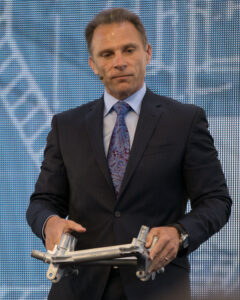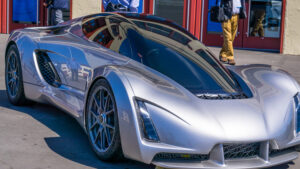Divergent Microfactories CEO Kevin Czinger unveils the Blade prototype, a car built from 3D printed components. Divergent is selling a process which Czinger says could help save the planet.
In a short keynote at the Solid conference in San Francisco, Kevin Czinger of Divergent Microfactories, Inc. explained how his company would redefine the automotive industry and save the world – or at least reduce the ongoing injury we’re inflicting via mass production. Czinger said he founded Divergent Microfactories as he came to realize that building electric cars and using alternative energy sources didn’t address the problem of inefficient uses of energy and global warming. As CEO of California-based Coda Automotive Czinger oversaw the development of Coda’s all-electric car in China. He says that as a result of working on the project in China, he experienced the terrible pollution of China and literally came face to face with the inherent contradictions of using conventional manufacturing methods to try and solve the problems of the environment.

Coda Automotive did not survive, the company went bankrupt in 2013. The company’s plan was to sell a determinedly ordinary looking electric car in China, the US and worldwide but car buyers were not interested, and maybe that’s alright. Czinger left Coda in 2010. His new company Divergent Microfactories is nothing less than an attempt to reboot the manufacturing process.
Czinger’s new car is built upon a revolutionary new model for the chassis. It’s constructed using modular 3D printed aluminum nodes connected with carbon fiber tubes. The ability to 3D print nodes enables low cost factories to be built anywhere and cars to be assembled quickly and cheaply. Czinger believes that car factories using the Divergent Microfactories model can be built for around $20 million and can build up to 10,000 cars a year. In contrast a modern car factory costs at least a billion dollars.
The company’s first prototype, the Blade, is a flashy baby. The company says the body is made from composite material, but they say, it can be made from anything – it’s not a structural part of the car. At about 1400 lbs, Czinger says the Blade is 90% lighter than the average automobile. It uses a 700 HP bi-fuel engine, which can run on gasoline or compressed gas, and is capable of going from 0-60 in 2 seconds.
It’s not electric?
As Czinger realized in China, simply building an electric car does not solve the problem. The exhaust from a car contributes only a fraction of the world’s pollution says Czinger citing Ozzie Zehner’s article Unclean at Any Speed in the IEEE Spectrum magazine, which notes that the manufacture of batteries for electric cars and the energy used to charge them is also problematic. Divergent Microfactories posits that when all is said and done, their model of manufacture coupled with an internal combustion engine capable of burning compressed gas can be the most efficient total bundle available. Czinger says the choices made in manufacture are actually a decision we make about our survival.

As hot as the Blade is, Divergent Microfactories isn’t necessarily selling a car, though there is that component in the plan. They are also selling a process. The company plans to license its technology to entrepreneurs around the world who will be able to use it to design and build their own cars using Divergent’s node-based chassis.
In an article published in the FT, Czinger said his plan is to raise $10 million to build a factory in Knoxville, Tennessee and build Blades. He believes the plant can break even at 2400 cars a year. The company hopes to scale up to 10,000 cars for customers. If he can make that work, then Divergent Microfactories hopes to license new factories worldwide. At the Solid Conference Czinger says that with centralized node manufacture and economies of scale, the cost of factories can come way down and he believes that automotive manufacture is just the start. He believes the model of Divergent Microfactories can be used to tackle other large manufacture challenges.
What do we think?
Siemens PLM CEO Chuck Grindstaff said recently that the automobile manufacturer that could figure out how to disintermediate the manufacturing process would be the ultimate winner. Is this what he meant?
Another new car company Local Motors is also looking at the idea of 3D printing car components and enabling more low cost, localized car manufacture. There are many movements bubbling up all focused on changing the current model of manufacture.
The research Czinger cites also says that our attitude of one car per person is also part of the crazy thinking that’s going to finish us off, so what is liable to be the most important part of the Divergent Microfactories experience is the ability to break apart the systems we put together at the turn of the last century and put together safer, more sustainable systems for this century.





